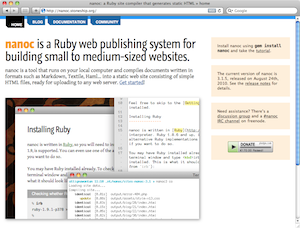I have been using Nanoc by Denis Defreyne more and more recently. It has that rare combination of simplicity and flexibility, and it is now my framework of choice for developing new, simple websites.
Nanoc is a static site generator

Like all static site generators, Nanoc takes a bunch of source files and transforms them into HTML pages. It nicely separates content from layout, allows for uncluttered source files using text filters, and provides hooks and scripts for common deployment tasks.
My typical workflow with Nanoc
My process of building websites using Nanoc typically looks like this:
- Create a new content item.
- Specify some metadata, like a title and description.
- Write content using Markdown.
- Let Nanoc compile the site and launch the built-in webserver.
- Test my work in the browser.
- Use Rake to check for valid HTML, CSS and links.
- When all is well use Rake to deploy to live server.
In the process, various scripts and filters apply templates, optimise my images, concatenate and minify my scripts and stylesheets and rewrite URLs for optimal caching performance. One central configuration file takes care of server settings, google analytics tracking codes, e-mail addresses and server connection settings.
What I like about this workflow is that lots of moving parts are neatly in place. When there are only really two tasks to perform (generate the site and deploy to the server) on which everything else is hooked, the process of site maintenance is greatly simplified. There is nothing to remember, it is all basically self-documenting (after you have gotten to know Nanoc, of course).
What’s more, the Ruby ecosystem Nanoc springs from is very vibrant and full of useful tools, making it much easier to stand on the shoulders of giants.1 And with the advent of Bundler, the last real hurdle of managing Ruby Gem dependencies has been overcome. I can now recreate and deploy my site in a couple of easy steps:
git clone repo.git
bundle install
nanoc co
rake deploy
That is:
- Clone Git repository;
- Let Bundler set up all required dependencies;
- Let Nanoc generate a fresh copy of my site;
- Let Rake push it to the live server.
These are simple steps that even teammates unfamiliar with the world of the terminal and Ruby can learn and use.
Shortcomings
Nanoc is not without its faults, and pinpointing them is, I think, both fun and a crucial step in improving the system.
-
The central
Rulesfile handles routing, layouts and filters. It can easily get cluttered, as you have to specify rules for all these seperately. -
Because Nanoc supports different data stores, working with a filesystem store is not as efficient as it could be.
-
Nanoc’s gem dependencies are unclear, requiring some trial and error and numerous
gem install’s to get all parts working. -
Item identifiers can be confusing, as they seem to – but don’t – map to file paths. This makes it difficult to have multiple items by the same name (like sitemap.xml and sitemap.html). Also, a file like
.htaccesshas no valid identifier, requiring you to route ahtaccess.txtfile to a.htaccessfile. It works, but to someone unfamiliar with the system, it is not immediately clear how. -
It can be confusing to sometimes use Rake and sometimes use Nanoc. Nanoc provides a few Rake tasks, and it is not obvious why the task ‘generate a new item’ would be handled by
nanocwhile ‘check for invalid links’ would be handled byrake. -
Nanoc can be slow sometimes, depending on your content and applied filters. There is an autocompiler that only compiles changed files as needed, but it is not perfect yet. It is especially cumbersome when an exception occurs and it quits.
-
content dependency resolution works pretty well, but sometimes files change, influencing other files but not triggering re-generation of those files. This applies to helpers and binary items mostly.
-
Nanoc hasn’t got a real good system in place for binary static cotent. Hacking your own solution for images, PDF’s and other stuff is not that bad, but as everything else is so neatly in it’s own place, it would be great to see some kind of convention evolving for this.
-
It can be cumbersome to generate files and filters manually. A generator system could cut down development time even more.
The fun thing with open source projects like Nanoc is that I can dive into the source code myself and adapt the system to my needs. And that is exactly what I intend to do with some of these issues I have.
Overall, I think Nanoc is a very well built and mature project, that is a joy to work with.
-
I used to develop static websites with a home-grown PHP-system. Although the PHP world shares a lot of code, it has neither the culture of neat libraries nor a system to easily distribute it, like Ruby has with gems. ↩